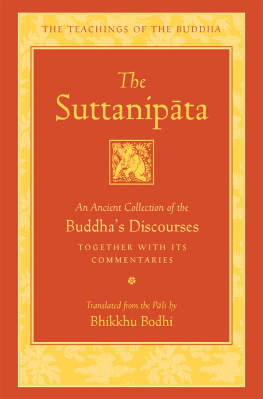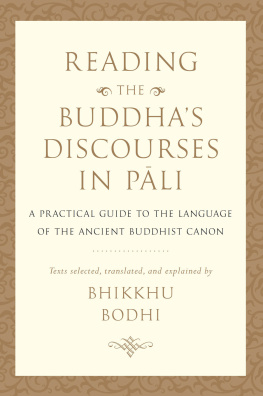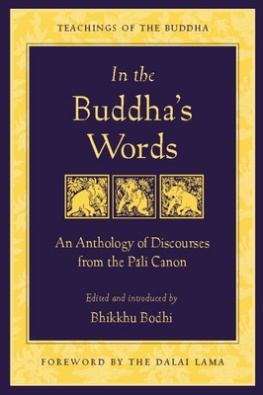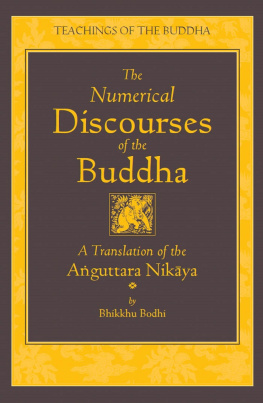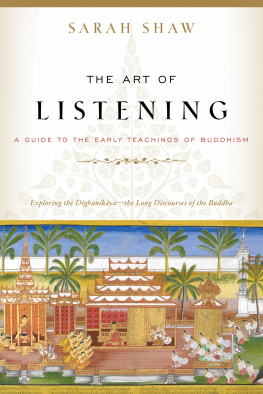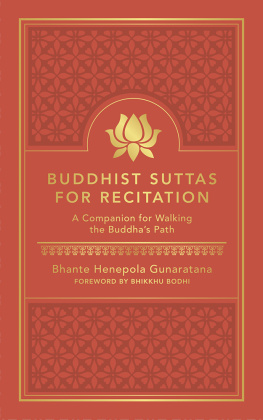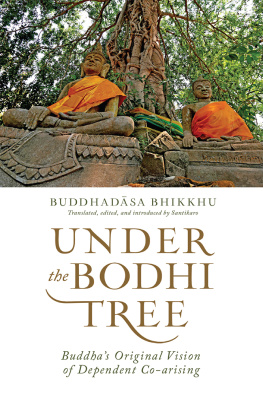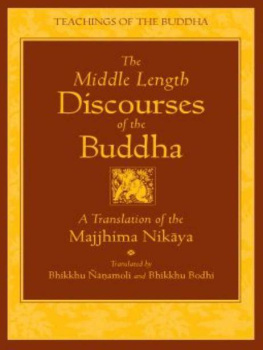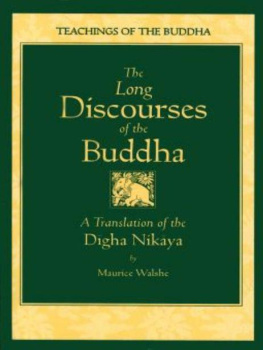THE TEACHINGS OF THE BUDDHA SERIES
The Buddhas Teachings on Social and Communal Harmony: An Anthology of Discourses from the Pli Canon
The Connected Discourses of the Buddha: A Translation of the Sayutta Nikya
Great Disciples of the Buddha: Their Lives, Their Works, Their Legacy
In the Buddhas Words: An Anthology of Discourses from the Pli Canon
The Long Discourses of the Buddha: A Translation of the Dgha Nikya
The Middle Length Discourses of the Buddha: A Translation of the Majjhima Nikya
The Numerical Discourses of the Buddha: A Translation of the Aguttara Nikya

Wisdom Publications
199 Elm Street
Somerville, MA 02144 USA
wisdompubs.org
2017 Bhikkhu Bodhi
All rights reserved.
No part of this book may be reproduced in any form or by any means, electronic or mechanical, including photography, recording, or by any information storage and retrieval system or technologies now known or later developed, without permission in writing from the publisher.
Library of Congress Cataloging-in-Publication Data is available .
LCCN 2016048003
ISBN 978-1-61429-429-0 ebook ISBN 978-1-61429-454-2
21 20 19 18 17
5 4 3 2 1
Design by Gopa&Ted2.
Set in TexGyrePagella 10/12.4.
Dedicated to the memory of two departed friends from my time in Sri Lanka
Ayy Nynasir
(19322004)
An American Buddhist woman who lived in Sri Lanka from 1978 until her death in 2004. An editorial assistant for the Buddhist Publication Society, ordained as a ten-precept nun in 1987, an inspiration to many of the English-speaking Sri Lankan Buddhist women in Kandy and Colombo, she was a great admirer of the Suttanipta who aspired to follow the muni ideal.
Bhikkhu Sumedha
(19322006)
A Swiss bhikkhu who lived in Sri Lanka from 1974 until his death in 2006, resident at the Manpadassana Cave near Doolwala, Kandy district. A brilliant artist with paint, brush, and words, a Dhamma teacher with keen insight into the teachings, he was also a monk of deep compassion who served as spiritual guide to doctors and patients at the Peradeniya Teaching Hospital.
Wherever these two departed friends may now be dwelling, may they rejoice in the knowledge that this translation is dedicated to their memory.
PUBLISHERS ACKNOWLEDGMENT
The publisher gratefully acknowledges the generous help of the Hershey Family Foundation in sponsoring the production of this book.
Preface
This volume offers a new translation of the Suttanipta together with its commentarial apparatus. The Suttanipta is an anthology of discourses ascribed to the Buddha, included in the Khuddaka Nikya, the Minor or Miscellaneous Collection, the fifth of the five nikyas that constitute the Sutta Piaka (or Compilation of Discourses) of the Pli Canon. The Suttanipta sits in this collection alongside such popular works as the Dhammapada, the Udna, and the Itivuttaka, and is itself a perennial favorite among followers of Theravda Buddhism. Most of the discourses in the Suttanipta are in verse, some in mixed prose and verse. None is entirely in prose. Several discourses in the Suttanipta are found in the main collections specifically in the Majjhima, Sayutta, and Aguttara Nikyas though most are unique to this anthology.
Linguistic and doctrinal evidence suggests that the Suttanipta took shape through a gradual process of accretion spread out over three or four centuries. The anthology is unique to the Pli Canon, though it contains discourses with parallels in other transmission lines among the schools of Early Buddhism. This implies that the Suttanipta itself was compiled within the Pli school from preexisting material. Several of its texts are considered to be among the most ancient specimens of Buddhist literature. Among these are two chapters, the Ahakavagga (chap. IV) and the Pryanavagga (chap. V), that are quoted in the Sayutta and Aguttara Nikyas. These two chapters are, moreover, the subjects of a two-part expository text, the Niddesa, so old that it was included in the Khuddaka Nikya. The Suttanipta also contains discourses that have been absorbed into the common Theravda monastic liturgy, among them the Metta Sutta and the Ratana Sutta, and popular discourses like the Parbhava Sutta and the Mahmagala Sutta that serve as the basis for Buddhist lay ethics. These suttas are often drawn upon by preachers of the Dhamma for their sermons to the laity.
The Suttanipta has been previously translated into English at least six times: by Robert Chalmers, Viggo Fausbll, E. M. Hare, Ven. H. Saddhtissa, K.R. Norman, and N.A. Jayawickrama. A German translation by Nyanaponika Thera is also available. A translation of the Ahakavagga by Bhikkhu Paobhsa has been published in a small printed edition, inclusive of the Pli text. Several chapters and individual suttas are posted on the website Access to Insight, most translated by hnissaro Bhikkhu. Another translation of the Ahakavagga, this one by Gil Fronsdal (2016), was published too late for me to consult when preparing the present work.
My intention, in preparing this work, was not to offer still another translation that would improve on the work of my predecessors and shake up the world of Buddhist scholarship with bold, innovative renderings. Rather, it was to make the Suttanipta available in an accurate and readable version along with its commentaries as preserved in the Pli Buddhist tradition. This is, I believe, the first time that the entire Suttanipta Commentary and substantial excerpts from the Niddesa have been published in translation.
I based my translation of the Suttanipta on three editions. I relied primarily on the excellent Roman-script edition by Dines Anderson and Helmer Smith, published by the Pali Text Society (PTS), but I also consulted two other versions. One is the electronic edition of the Burmese Chaha Sagyana Tipiaka, the Sixth Council compilation, published by the Vipassana Research Institute and available online (designated CST4). The other is the Sinhala-script Buddha Jayanti edition published in Sri Lanka, now available online as a PDF. Occasionally I preferred a reading in one or another (or both) of these editions to that in the PTS edition. When I do so, I have usually mentioned my preference in a note. My numbering scheme follows that of the PTS edition.
In preparing my translation of the Suttanipta I regularly consulted the careful and precise translations by Norman and Jayawickrama and often refer to them in my notes. I also found Normans endnotes (which take up 300 pages of his 430-page volume, The Group of Discourses ) particularly helpful in understanding the text from a philological perspective. Jayawickramas monograph, A Critical Analysis of the Suttanipta, gave me insights into the works historical and linguistic development. The two translations I consulted most often occasionally differ due to their divergent approaches. Normans aim, as he expresses it in his preface, is to give the meaning of the text as it was intended to be understood by the original speakers, or as it was accepted by the first hearers (GD x). This is a tall order for one living so far from the culture and environment in which the Suttanipta took shape, but Norman brought to the task his consummate knowledge of Middle Indo-Aryan languages. Jayawickrama, in contrast, leans heavily on the commentary and thus follows more closely traditional Theravdin exegesis.
In my translation I have tried to steer a middle course between the two. I sought to remain faithful to the words of the text when it is clear, simple, and straightforward. Since this is not always the case, I relied on the commentary to understand more difficult verses and obscure words and expressions. There were, however, places where I had to differ from the commentary, even when doing so created a dissonance between my rendering of the root text and the commentary. I have noted these discrepancies in the introduction ( pp. 7881 ), where I refer to the notes that explain my disagreements. Also, unlike Norman and Jayawickrama, I have composed my translation in free verse. Since I am not a poet, I did not aim at poetic elegance but simply at rendering the verses in a style that is more uplifting and less pedantic than a bare prose translation.
Next page
